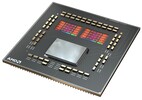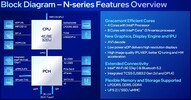AMD Ryzen 7 5700X vs Intel Processor N97 vs Intel Processor N50
AMD Ryzen 7 5700X
► remove from comparison
The AMD Ryzen 7 5700X is a desktop processor with 8 cores and simultaneous multithreading (SMT), which means it can process 16 threads simultaneously. In April 2022, AMD presented the Ryzen 7 5700X, a new 8-core processor that is very similar to the AMD Ryzen 7 5800X. However, due to the lower TDP, there are no restrictions on the clock frequency. Nevertheless, the AMD Ryzen 7 5700X reaches up to 4.6 GHz in boost, which is only 100 MHz less than the AMD Ryzen 7 5800X. However, the base clock drops significantly to 3.4 GHz.
The performance of the AMD Ryzen 7 5700X is consistently excellent in all applications. The native 8-core can really show off its strengths, especially in multi-threaded applications, although the single-core performance has also been significantly improved compared to the older Zen 2 architecture.
The internal structure of the processor is similar to the AMD Ryzen 7 5800X. The CCX modules are also connected to each other via the I/O die, which we already know from Zen2. However, according to AMD, the Infinity Fabric should now achieve clock rates of up to 2 GHz, which in turn enables a RAM clock rate of 4,000 MHz without any loss of performance.
In terms of manufacturing processes, AMD also relies on TSCM for the 7nm production of the CPU cores in the Vermeer processors, although the I/O die is still supplied in 12 nm by Globalfoundries.
The AMD Ryzen 7 5700X is impressive in gaming thanks to the significantly improved IPC compared to Zen2. In terms of power consumption, the AMD Ryzen 7 5700X impresses with its low TDP of just 65 watts. This means that the processor can also be operated with a compact air cooler without any problems. The AMD Ryzen 7 5800X is operated with a TDP of 105 watts.
Intel Processor N97
► remove from comparison
The Intel Processor N97 is an entry-level mobile CPU for thin and light laptops from the Alder Lake-N series. It was announced in early 2023 and offers no performance cores and 4 of the 8 efficient cores (E-cores, Gracemont architecture). The chip does not support HyperThreading and clocks with up to 3.7 GHz. The performance of the E-cores should be similar to old Skylake cores (compare to the Core i7-6700HQ). All cores can use up to 6 MB L3-cache.
Performance
The performance should be between the Intel Processor N100 and Intel Processor N200 and clearly below the Core i3-N300 and N305 due to the reduced core count.
Features
The Alder Lake-N chips only support single channel memory with up to DDR5-4800, DDR4-3200 or LPDDR5-4800. The chip also supports Quick Sync and AV1 decoding (most likely same engine as in Alder Lake). Furthermore, Wi-Fi 6E and Bluetooth 5.2 are partly integrated (but no Thunderbolt). External chips can be connected via PCIe Gen3 x9 (via the PCH).
The integrated graphics adapter is based on the Xe-architecture and offers only 24 of the 32 EUs (Execution Units) operating at 1200 MHz. Due to the single channel memory, low clock speeds, and low shader count, the gaming performance of the iGPU is very limited.
Power consumption
The N97 has a base power consumption of 12 W and therefore double the amount of the N100. The CPU is built with a further improved 10nm SuperFin process at Intel (called Intel 7).
Intel Processor N50
► remove from comparison
The Intel Processor N50 is an entry-level mobile CPU for thin and light laptops from the Alder Lake-N series. It was announced in early 2023 and offers no performance cores and 2 of the 8 efficient cores (E-cores, Gracemont architecture). The chip does not support HyperThreading and clocks with up to 3.4 GHz. The performance of the E-cores should be similar to old Skylake cores (compare to the Core i7-6700HQ). All cores can use up to 6 MB L3-cache.
Performance
The performance is clearly lower than the Processor N100 (4 cores, 3.4 GHz) due to the reduced core count. The single thread performance however, should be similar. Compared to older processors, the N50 should be comparable to dual core Skylake based CPUs like the Intel Core m3-8100Y (2x 3.4 GHz, 5W).Features
The Alder Lake-N chips only support single channel memory with up to DDR5-4800, DDR4-3200 or LPDDR5-4800. The chip also supports Quick Sync and AV1 decoding (most likely same engine as in Alder Lake). Furthermore, Wi-Fi 6E and Bluetooth 5.2 are partly integrated (but no Thunderbolt). External chips can be connected via PCIe Gen3 x9 (via the PCH).
The integrated graphics adapter is based on the Xe-architecture and offers only 16 of the 32 EUs (Execution Units) operating at only up to 750 MHz. Due to the single channel memory, low clock speeds, and low shader count, the gaming performance of the iGPU is very limited.
Power consumption
The N50 has a base power consumption of only 6 W and is therefore suited for fanless cooling. The CPU is built with a further improved 10nm SuperFin process at Intel (called Intel 7).
| Model | AMD Ryzen 7 5700X | Intel Processor N97 | Intel Processor N50 | ||||||||||||||||||||||||||||||||||||||||||||||||||||||||||||||||||||||||
| Codename | Vermeer (Zen 3) | Alder Lake-N | Alder Lake-N | ||||||||||||||||||||||||||||||||||||||||||||||||||||||||||||||||||||||||
| Series | AMD Vermeer (Ryzen 5000) | Intel Alder Lake-N | Intel Alder Lake-N | ||||||||||||||||||||||||||||||||||||||||||||||||||||||||||||||||||||||||
| Series: Alder Lake-N Alder Lake-N |
|
|
| ||||||||||||||||||||||||||||||||||||||||||||||||||||||||||||||||||||||||
| Clock | 3400 - 4600 MHz | <=3600 MHz | 1000 - 3400 MHz | ||||||||||||||||||||||||||||||||||||||||||||||||||||||||||||||||||||||||
| L1 Cache | 512 KB | ||||||||||||||||||||||||||||||||||||||||||||||||||||||||||||||||||||||||||
| L2 Cache | 4 MB | ||||||||||||||||||||||||||||||||||||||||||||||||||||||||||||||||||||||||||
| L3 Cache | 32 MB | 6 MB | 6 MB | ||||||||||||||||||||||||||||||||||||||||||||||||||||||||||||||||||||||||
| Cores / Threads | 8 / 16 | 4 / 4 4 x 3.6 GHz Intel Crestmont E-Core | 2 / 2 2 x 3.4 GHz Intel Gracemont E-Core | ||||||||||||||||||||||||||||||||||||||||||||||||||||||||||||||||||||||||
| TDP | 65 Watt | 12 Watt | 6 Watt | ||||||||||||||||||||||||||||||||||||||||||||||||||||||||||||||||||||||||
| Technology | 7 nm | 10 nm | 10 nm | ||||||||||||||||||||||||||||||||||||||||||||||||||||||||||||||||||||||||
| Die Size | 2 x 74 sq. mm; I/O = 125 sq. mm mm2 | ||||||||||||||||||||||||||||||||||||||||||||||||||||||||||||||||||||||||||
| max. Temp. | 90 °C | 105 °C | 105 °C | ||||||||||||||||||||||||||||||||||||||||||||||||||||||||||||||||||||||||
| Socket | 1331 | ||||||||||||||||||||||||||||||||||||||||||||||||||||||||||||||||||||||||||
| Features | MMX(+), SSE, SSE2, SSE3, SSSE3, SSE4.1, SSE4.2, SSE4A, x86-64, AMD-V, AES, AVX, AVX2, FMA3, SHA, Precision Boost 2 | ||||||||||||||||||||||||||||||||||||||||||||||||||||||||||||||||||||||||||
| Architecture | x86 | x86 | x86 | ||||||||||||||||||||||||||||||||||||||||||||||||||||||||||||||||||||||||
| $299 U.S. | |||||||||||||||||||||||||||||||||||||||||||||||||||||||||||||||||||||||||||
| Announced | |||||||||||||||||||||||||||||||||||||||||||||||||||||||||||||||||||||||||||
| Manufacturer | www.amd.com | ark.intel.com | ark.intel.com | ||||||||||||||||||||||||||||||||||||||||||||||||||||||||||||||||||||||||
| iGPU | Intel UHD Graphics 24EUs (Alder Lake-N) ( - 1200 MHz) | Intel UHD Graphics Xe 16EUs (Tiger Lake-H) ( - 750 MHz) |
Benchmarks
Average Benchmarks AMD Ryzen 7 5700X → 100% n=4
Average Benchmarks Intel Processor N97 → 47% n=4
Average Benchmarks Intel Processor N50 → 36% n=4
* Smaller numbers mean a higher performance
1 This benchmark is not used for the average calculation













